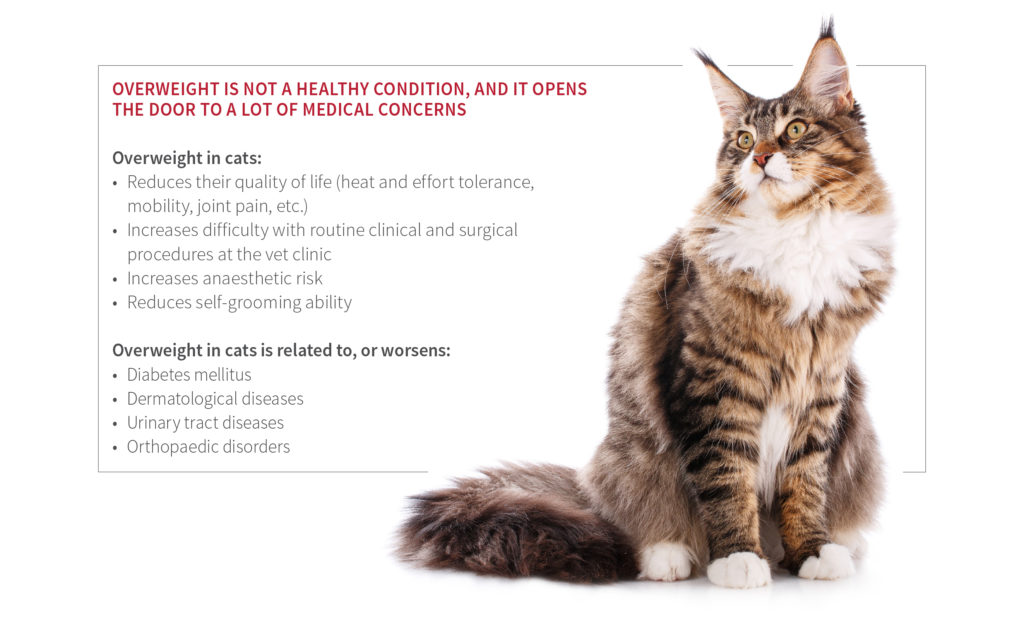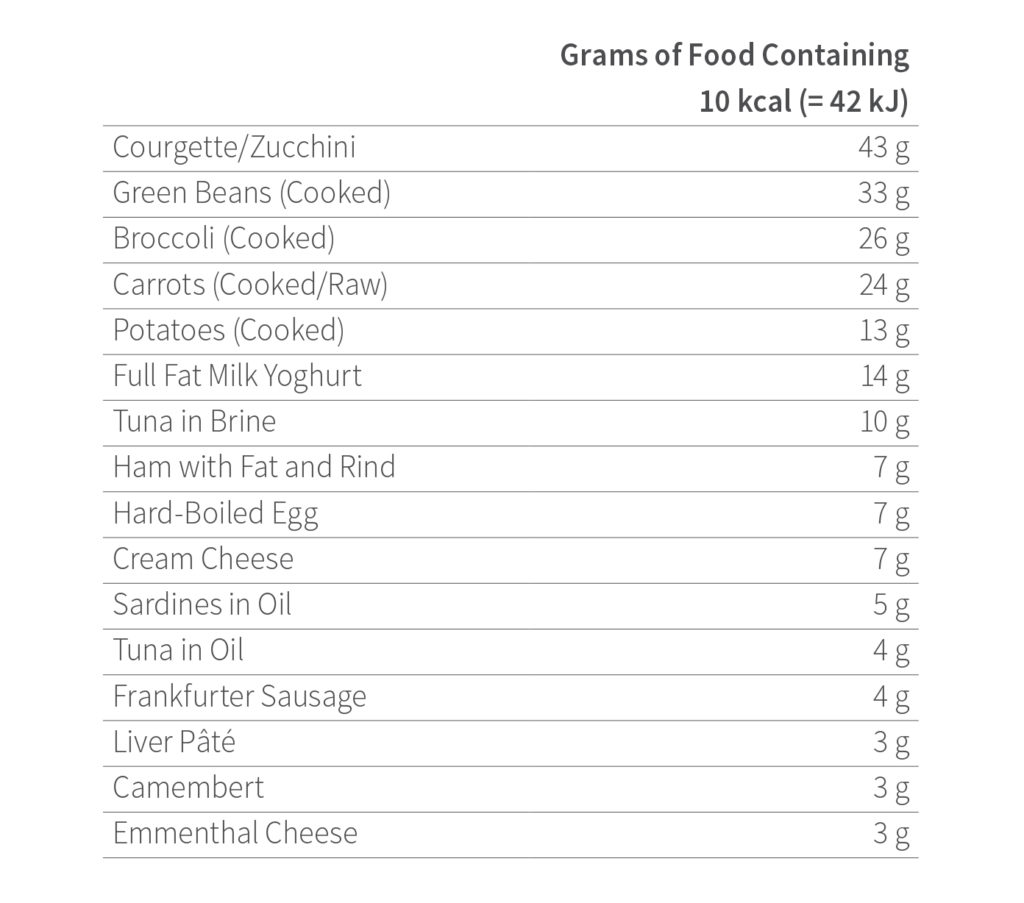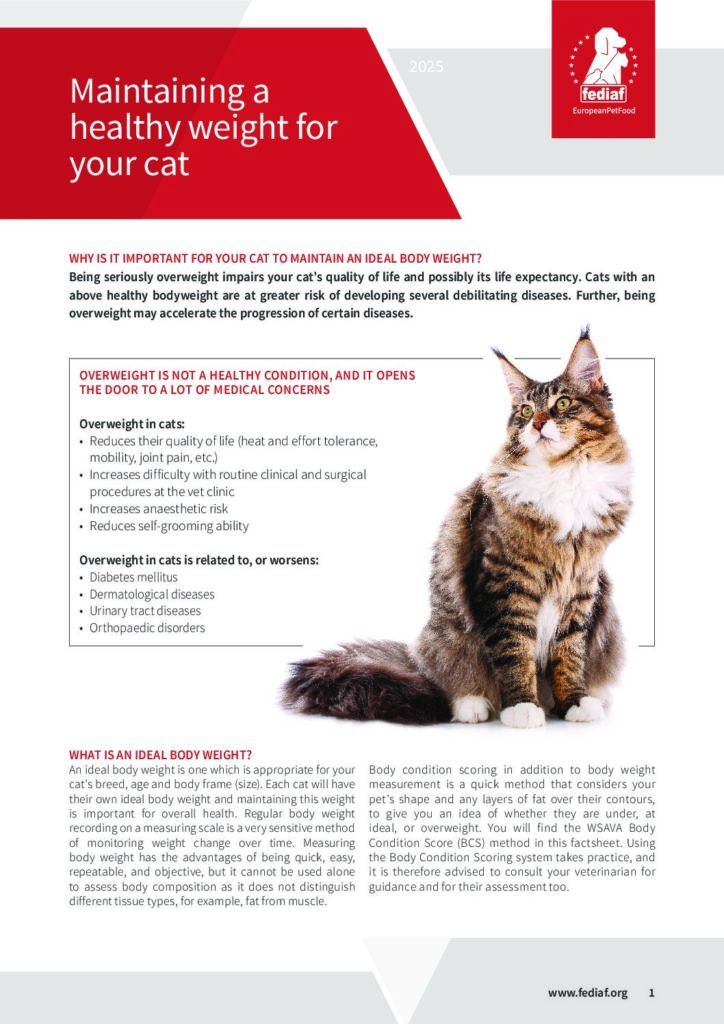Maintaining a healthy weight for your cat Factsheet
Why is it important for your cat to maintain an ideal body weight?
Being seriously overweight impairs your cat’s quality of life and possibly their life expectancy. Cats with an above healthy bodyweight are at greater risk of developing several debilitating diseases. Further, being overweight may accelerate the progression of certain diseases.

What is an ideal body weight?
An ideal body weight is one which is appropriate for your cat’s breed, age and body frame (size). Each cat will have their own ideal body weight and maintaining this weight is important for overall health. Regular body weight recording on a measuring scale is a very sensitive method of monitoring weight change over time. Measuring body weight has the advantages of being quick, easy, repeatable, and objective, but it cannot be used alone to assess body composition as it does not distinguish different tissue types, for example, fat from muscle. Body condition scoring in addition to body weight measurement is a quick method that considers your pet’s shape and any layers of fat over their contours, to give you an idea of whether they are under, at ideal, or overweight (Body Condition Score (BCS), WSAVA). The method is shown overleaf. Using the Body Condition Scoring system takes practice, and it is therefore advised to consult your veterinarian for guidance and for their assessment too.
Body Condition Scoring System
- Optimal body weight (BCS 5/9): Your cat is at ideal body weight, maintain this condition. In some cases, BCS 6/9 may be acceptable, but make sure it does not increase from there. Seek your veterinarian´s advice.
- Underweight (at or below BCS 4/9): Your cat is underweight and needs your help to gain some weight to ensure optimal health. Seek your veterinarian´s advice.
- Overweight (above BCS 6/9): Your cat is overweight or obese, and this affects their quality of life. Your cat needs to lose weight to get back to optimal health. Seek your veterinarian´s advice.

Monitor your cat’s body condition and body weight regularly
Start to assess your cat’s body condition as early in your cat´s life as possible, even during growth.
Seeing your cat every day can impair your perception, which makes detecting over- or underweight challenging. This underscores the importance of regularly monitoring your cat’s weight using a scale as well as body condition scoring. It is much easier to help your cat maintain a lifelong ideal weight, if the feeding amount is adjusted based on minor weight changes than having to undergo a full weight loss program when your cat becomes visually overweight (BCS 6-7/9 or above).
Be particularly careful with kittens. Overfeeding kittens may result in fast growth, putting them at risk of being overweight for life. You can monitor their growth rate using growth charts, available from your veterinarian.
Risk factors for overweight in cats
Risk factors affecting the number of calories your cat needs per day:
Sex – neutered male cats may have a slightly higher risk of being overweight than female cats.
Neutering – when a cat is neutered, the production of the hormones oestrogen and testosterone decreases. A main reason why neutering (or decrease hormones) increases the risk of overweight is that it can affect the cat’s ability to feel full and they may eat more.
Age – increasing age may reduce your cat’s mobility and activity level and diet adjustments may be necessary to avoid weight gain.
Breeds – Cats of any breed may become overweight, but possibly domestic short- and longhaired cats, British shorthaired, Main coon, Norwegian forest cats and mixed breed cats may be at greater risk to become overweight compared with other purebred cats.
Inactivity – inactivity decreases your cat’s daily energy need. Cats that do not have outdoor access have a lower energy requirement and may be more inclined to seek the food bowl. Most indoor confined cats will overeat if their food is not rationed.
Post weight loss – Cats that have been overweight in the past are prone to becoming overweight again, so care should be taken with feeding amounts. Keep a close eye to prevent weight creeping back on.
Risk factors affecting the number of calories your cat needs per day:
Diet choice – Cats might eat too much energy if the diet of choice does not provide adequate satiety, therefore it is important to choose a diet with the calorie content adjusted to the cat’s life-stage (e.g., kitten or senior) and lifestyle (e.g., living indoor or outdoors). “Light” diets and veterinary weight loss diets have a lower calorie content compared to regular diets, but have increased nutrients to ensure that your cat still gets adequate nutrition, despite a lower calorie intake. The increased fibre and protein content found in these types of food can help with fullness, and meal sizes can be bigger. However, if kibbles are too small, cats might eat too quickly, consuming too much energy before satiety signals have time to take effect.
Wet/canned diets contain more water, which may increase satiety for some cats. Your veterinarian or cat nutritionist can help you choose an appropriate diet for your cat.
Feeding management – Cats are often not good at regulating their food intake when fed ad libitum (free availability of food) and it is not recommended for the obese prone cats. Twice-daily feeding may help protect against weight gain compared with once a day feeding. Furthermore, measuring the feeding amount using a scoop or cup is imprecise and it may be tempting to top a little bit extra when reaching the allocated mark. Weighing the food provides a more precise feeding amount.
Feeding enrichment – feeding enrichment provides physical and mental stimulation for the cat and it increases the time spent on ingesting the food, possibly improving satiation. Feed dry food or treats in puzzles, smear wet food to increase licking time, play hide and seek or other games that activates your cat and strengthens your bond
Treats and chews – Giving treats may be an integral part of our daily interaction and supports bonding with your cat. However, it is important to keep in mind that treats and chews provide your cat with additional calories, just like human snacks. Therefore, treats and any other complementary feed should never comprise more than 10% of your cat´s daily calorie needs.
Table scraps – Feeding table scraps is another source for additional calories. It can stimulate begging behaviour that may be hard ignore. Calories from table scraps must be included in the 10% allowance mentioned above. Ensure table scraps are not toxic for cats or cause tummy upset.
How to avoid unwanted weight gain in your cat
It is very important to avoid weight gain because it is much easier to gain weight than to lose it.
- Monitor your cat’s weight and body condition score – weigh them whenever possible, preferably monthly. Consider using a baby scale at home for routine weighing and adjust your feeding practices accordingly.
- Feed an appropriate life-stage diet, so that the calorie content is adapted to your cat’s age. Kittens need more calories for their growth. During senior life-stage energy requirements might change and adaption might be needed.
- Reduce your cat’s feeding amount following neutering.
- Adjust your cat’s diet according to activity level, indoor cats have a lower energy need compared to outdoor cats.
- Keep your cat in good mental and physical condition – let your cat work for the food and plan exercise periods of 10 minutes during the day adjusting the number to your cat’s needs.
- Measure your cat’s dry feed on a scale – there is a greater risk of overfeeding when using cups or other volume measures.
- The total daily quantity of treats and table scraps should never amount to more than 10% of your cat’s daily calorie need. Make sure to decrease the amount of their main meal accordingly.
- Carefully follow the feeding instructions when changing to a new food and monitor your cat’s weight and body condition score following the transition.
- Wet diet or soaking the dry diet may improve satiety in some cats.
What weight of food contains 10 kilocalories (kcal)?
Use the chart below for selected treats and foods

How many calories is 10% of overall daily calories for cats from 2.5 to 7 kg in ideal body condition?
Use this simple chart

How to obtain a healthy weight if my cat is overweight
If your cat is already overweight (BCS 7/9 or above), you can help them by engaging in a weight loss program and your veterinary health care team can guide you on how to plan and manage this successfully. The closer to the healthy weight when you start, the easier it is. Because the daily calories will have to be significantly decreased, your cat will have to be switched to a balanced weight loss diet, where the nutrient content is increased to accommodate the lower calorie intake.
Furthermore, these diets often have increased protein and/or fibre content, which helps your cat to feel full, despite the lower calorie content.
Further Reading:
Chandler, M. (2018). New thoughts about obesity. Companion Animal, 23(12), 686-695. https://doi.org/10.12968/coan.2018.23.12.686
Chiang, C. F., Villaverde, C., Chang, W. C., Fascetti, A. J., & Larsen, J. A. (2022). Prevalence, risk factors, and disease associations of overweight and obesity in cats that visited the Veterinary Medical Teaching Hospital at the University of California, Davis from January 2006 to December 2015. Topics in companion animal medicine, 47, 100620. https://doi.org/10.1016/j.tcam.2021.100620
De Godoy, M. R. C., & Swanson, K. S. (2013). Companion animals symposium: nutrigenomics: using gene expression and molecular biology data to understand pet obesity. Journal of animal science, 91(6), 2949-2964. https://doi.org/10.2527/jas.2012-5860
German, A. J. (2006). The growing problem of obesity in dogs and cats. The Journal of nutrition, 136(7), 1940S-1946S. https://doi.org/10.1093/jn/136.7.1940S
Larsen, J. A. (2017). Risk of obesity in the neutered cat. Journal of feline medicine and surgery, 19(8), 779-783. https://doi.org/10.1177/1098612X16660605
Hoelmkjaer, K. M., & Bjornvad, C. R. (2014). Management of obesity in cats. Veterinary Medicine: Research and Reports, 97-107. https://doi.org/10.2147/VMRR.S40869
Zoran, D. L. (2010). Obesity in dogs and cats: a metabolic and endocrine disorder. Veterinary Clinics: Small Animal Practice, 40(2), 221-239. https://doi.org/10.1016/j.cvsm.2009.10.009
